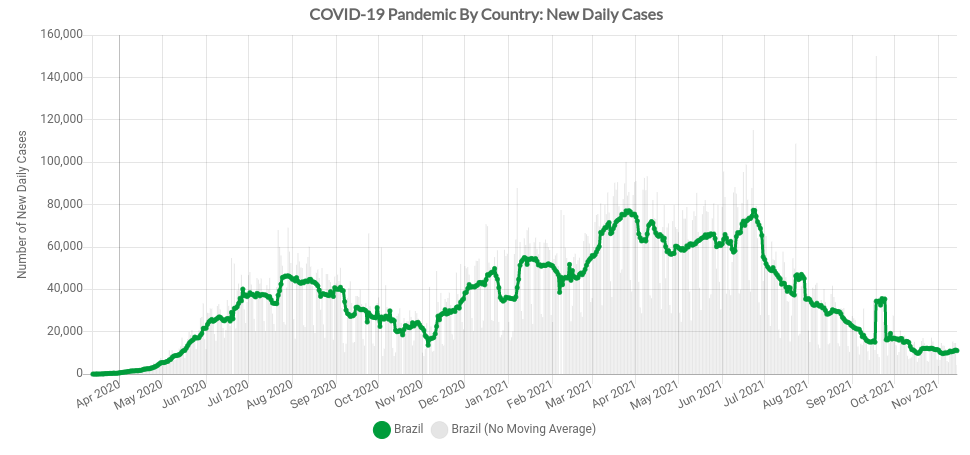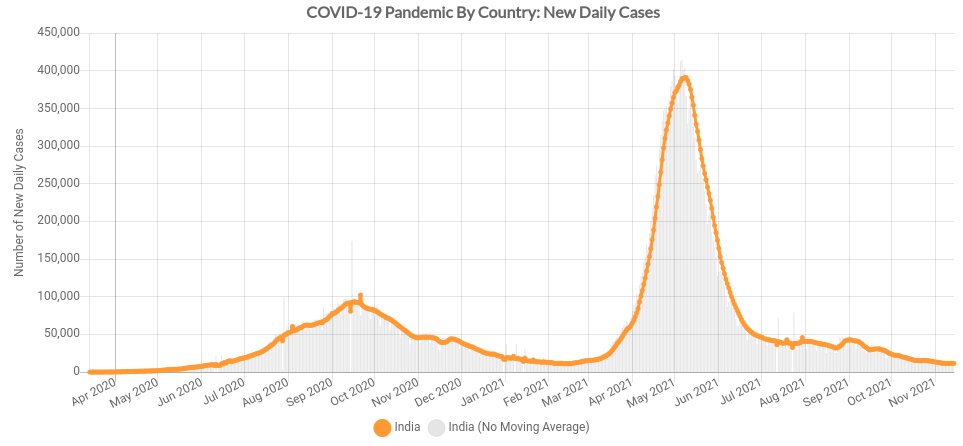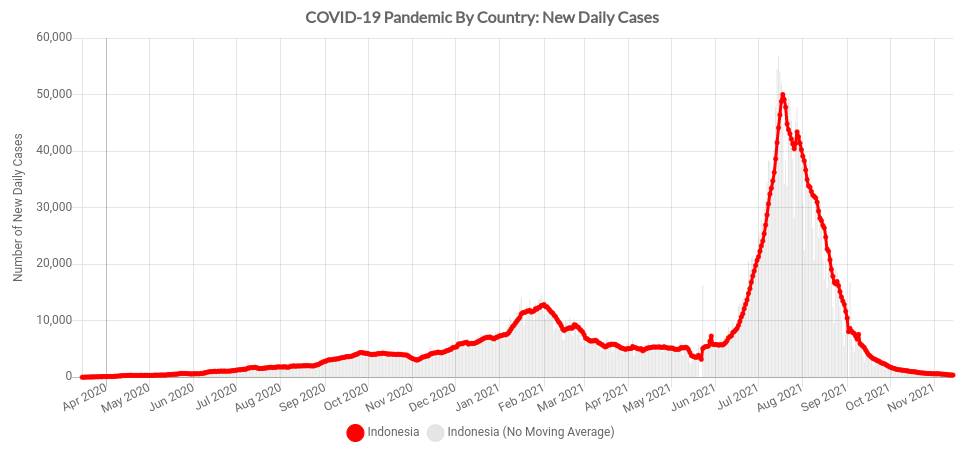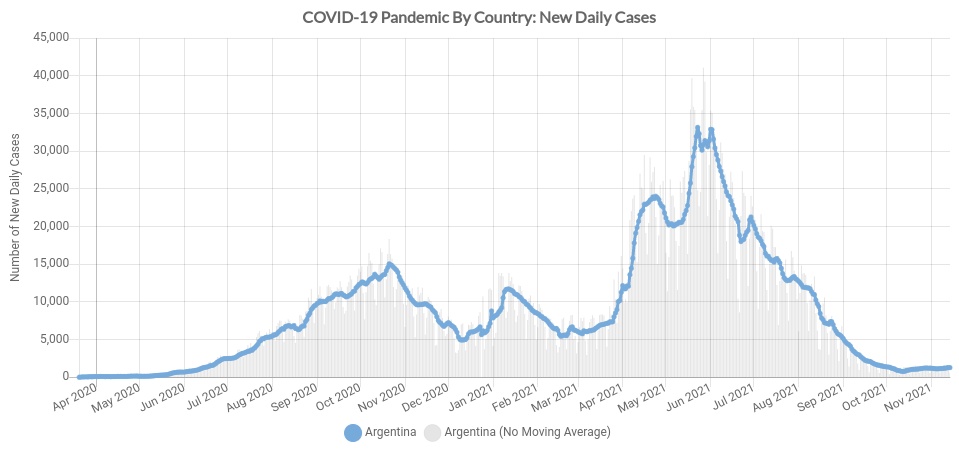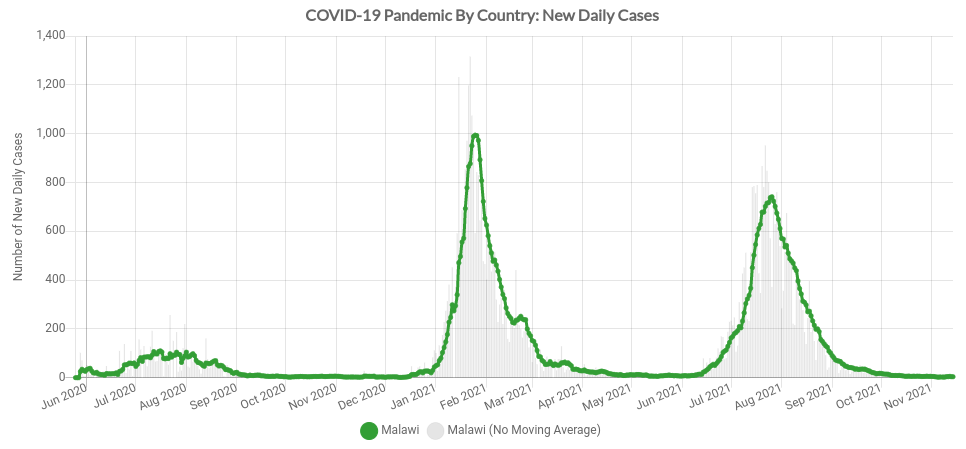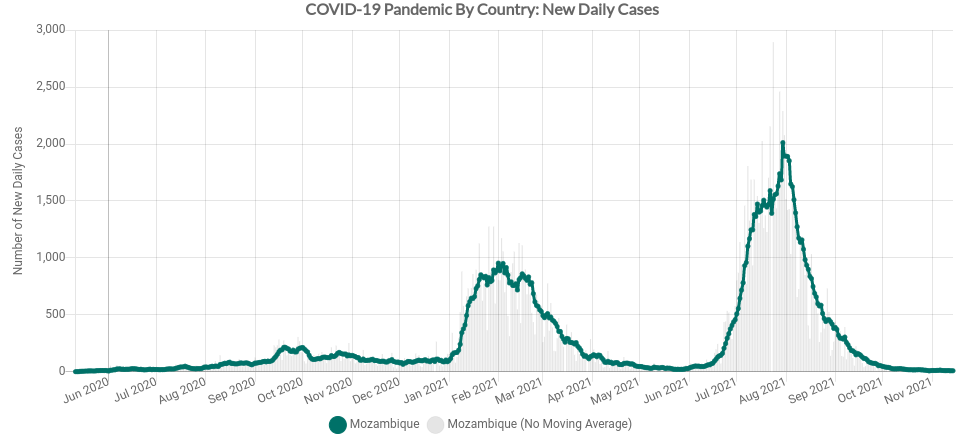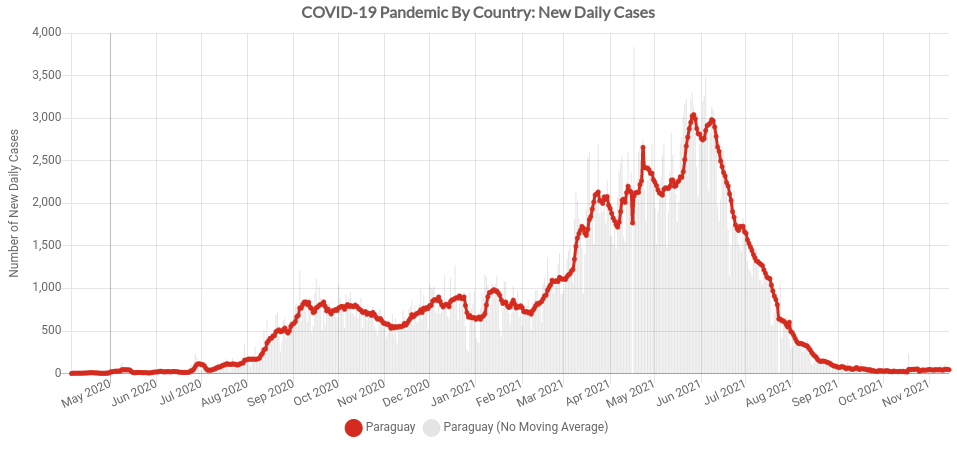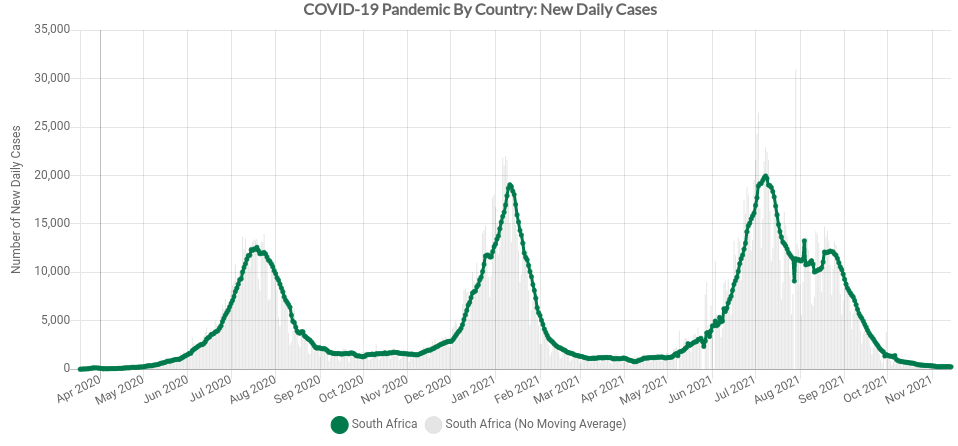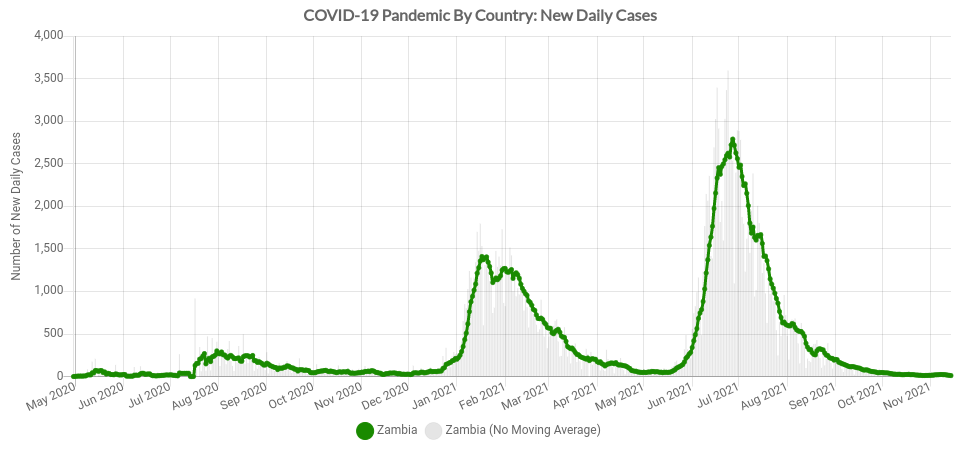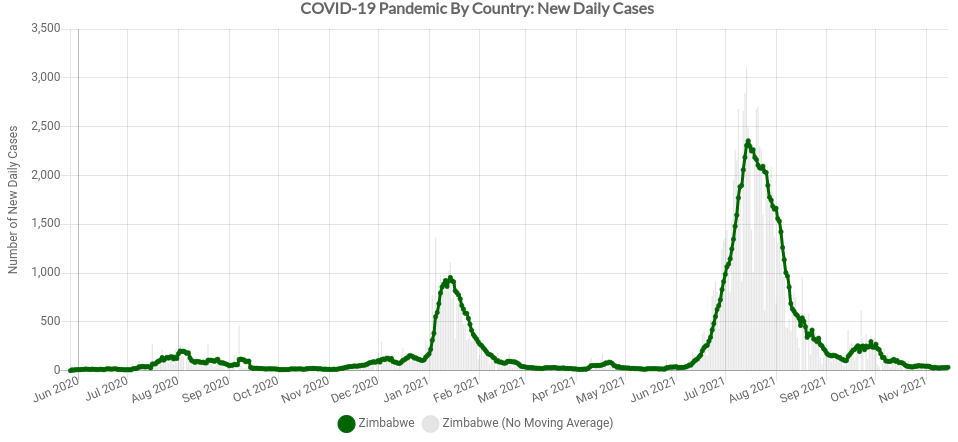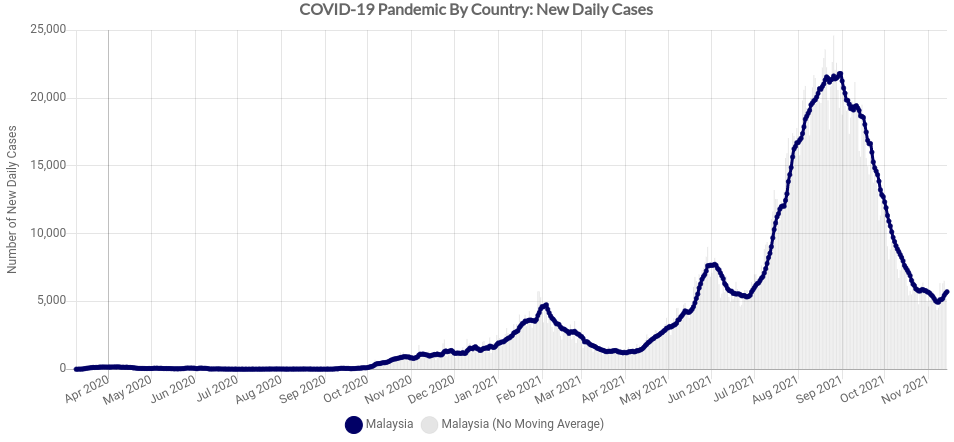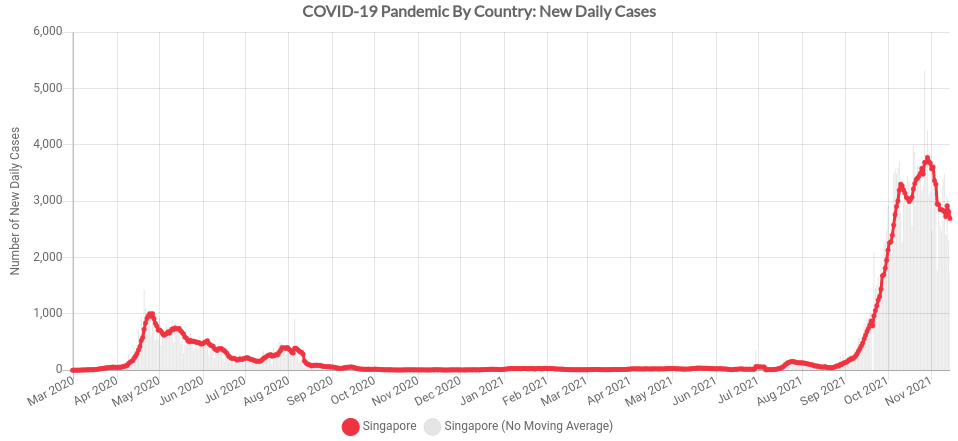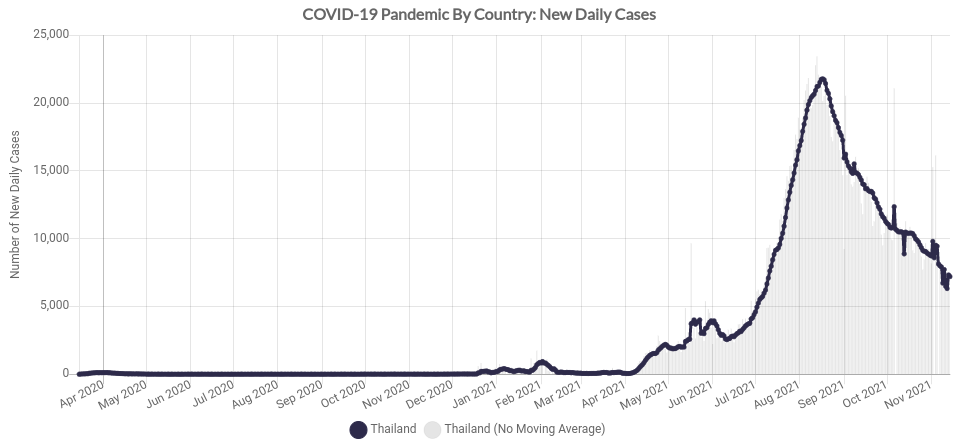As the COVID-19 pandemic grinds on towards its two-year anniversary, we’re all wondering when it will finally end. As vaccines fully rolled out to the general public last spring, the United States managed to get new case loads below 10,000 per day. But then the Delta Variant came along. Just like that, it dashed our hopes for a smooth transition to post-pandemic life. The Delta variant will likely set the end game of the COVID-19 pandemic back by a year.
I also believe that the Delta Variant is so dominant that it will ultimately help us end the COVID-19 pandemic sooner. How is that, you ask? It’s actually quite simple
- It blocks other potentially vaccine-resistant variants from taking hold. The Mu Variant that everyone thought was vaccine-resistant has been eradicated. No other variants have been able to establish themselves since Delta became dominant.
- It spreads so fast that most places will reach herd immunity faster.
- Treatments continue to improve, which will help drive down the death rate
Furthermore, the models have spoken loud and clear about the outlook for this winter and the end game for the COVID-19 pandemic. And they’re largely in agreement, too. Barring some freak mutant variant emerging, the COVID-19 pandemic will finally start winding down in 2022.
End Game in the United States: COVID-19 Has Started Shifting from Pandemic to Endemic
As soon as COVID-19 began to spread around the world, it became clear the the only end game is for the virus to become endemic. In its final endemic phase, the virus continues to circulate through the population, but at a much slower rate than during the pandemic phase. As treatments become more effective and widely available, the virus becomes much less dangerous. Many infectious disease experts predict that once COVID-19 reaches its final endemic stage, it will be a similar threat to the flu or the common cold.
Current Status of the COVID-19 Pandemic in the United States
First, let’s look back at what the COVID-19 map looked like back in the summer. Highly vaccinated areas had largely suppressed COVID-19 spread. On the other hand, the Delta variant had set the southeast on fire, where you could find the lowest vaccination rates in the country.
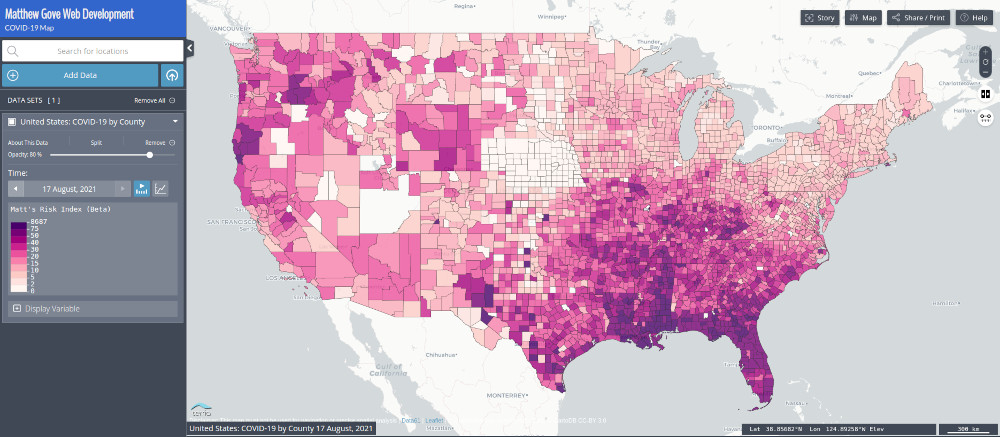
By September, the epicenter had spread north and west, hitting the Inner Mountain West and the Ohio Valley particularly hard. Both areas still have large pockets of unvaccinated residents.
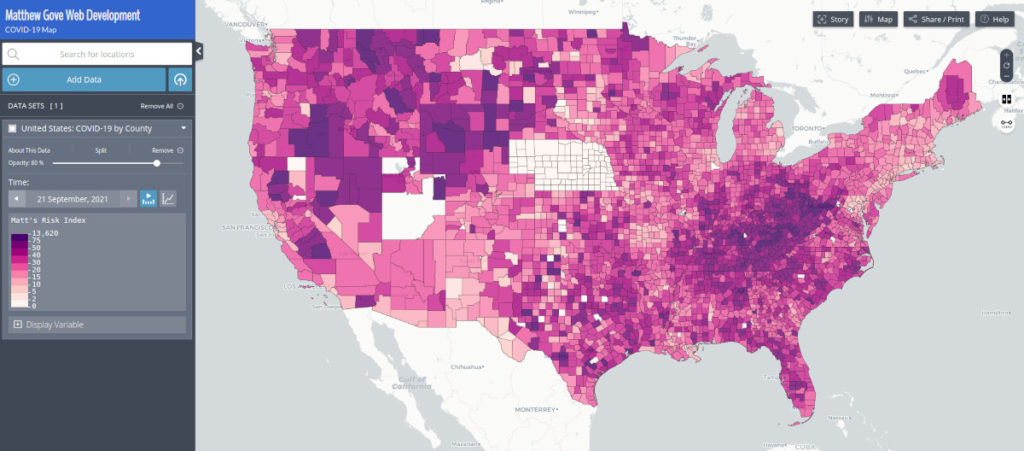
Today, the summer wave has largely subsided. The last dregs of it are rolling through the upper midwest and the northeast, as well as parts of the southwest. All in all, the country is in much better shape than it was back in September. Additionally, notice how the current map looks almost like the inverse of the August map. If reinfections are not occurring in the hard-hit southeast, that’s a major step forward to reaching herd immunity.
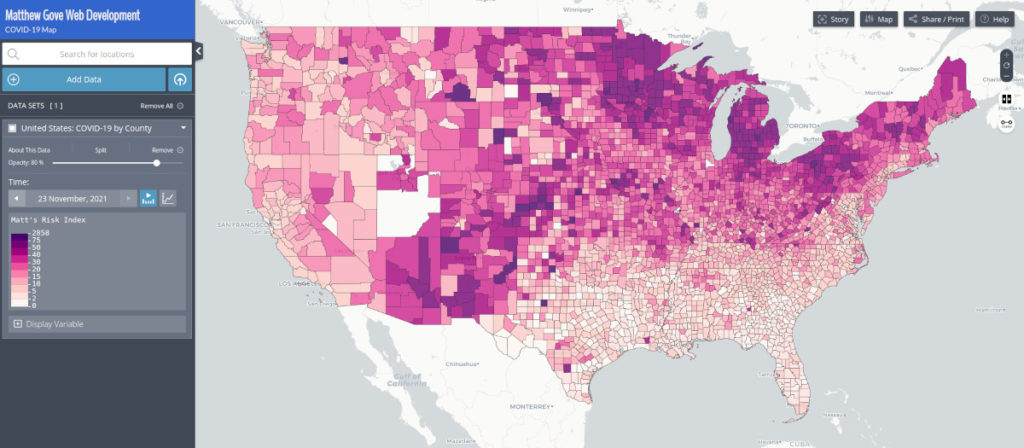
Despite the threat of another wave, I do not see any scenario where the United States implements more COVID-19 restrictions. Pandemic fatigue is real, and it’s unlikely further restrictions will be effective. So what exactly lies ahead? Let’s dive into the models.
University of Washington IHME Model
The University of Washington’s Institute for Health Metrics and Evaluation Model remains the gold standard go-to model in the United States. Everyone from the White House to the media to everyday citizens like you and me use it to plan their lives amidst the COVID-19 pandemic.
Before we dive into the cases and deaths, let’s first look at mobility and vaccination projections. Both parameters will help us understand the big picture. Lots of people will be traveling for the holidays this year, even though large pockets of the population remain unvaccinated. First, let’s look at the vaccination projections.
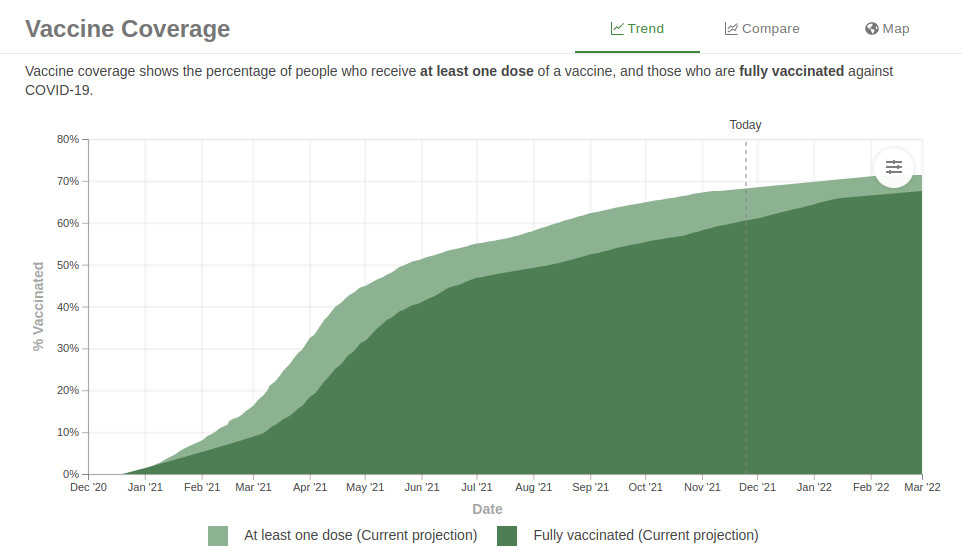
One thing really jumps out at me here. The model projects that vaccine coverage will basically plateau starting in January 22, with 63% of the population fully vaccinated. With a population of 330 million, that means that 125 million people in the United States will remain unvaccinated. Thankfully, that should be high enough to keep hospitals from being completely overwhelmed.
As for mobility, the IHME agrees with my prediction that the United States will not implement any further restrictions. Mobility should approach its pre-pandemic levels in early 2022.
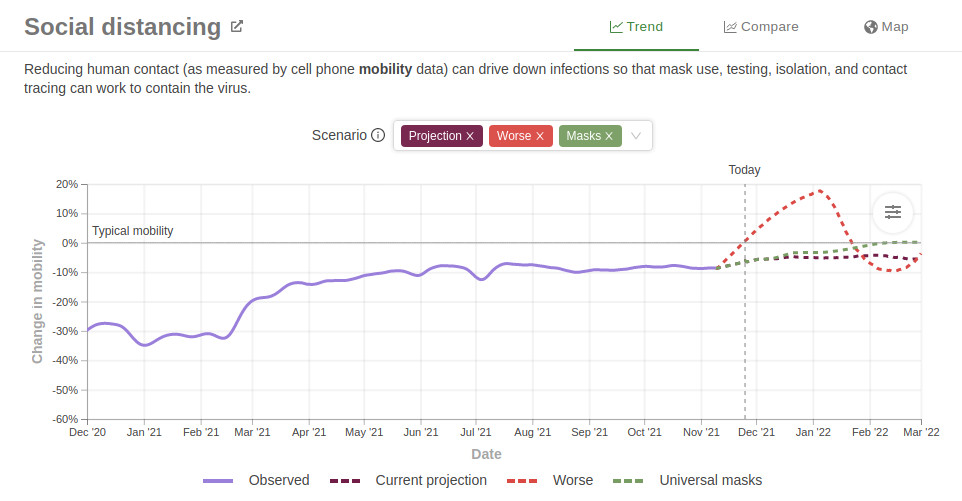
Do Case Loads Lead to the End of the COVID-19 Pandemic?
Before we look towards the end of the COVID-19 pandemic in the United States, there is still one final hurdle to clear: the holidays. Remember that in 2020, holiday travel and gatherings sent COVID-19 cases spiking to nearly 300,000 per day in the U.S. Things are much different this year, but the threat of another wave is still very real.
A fifth wave in the United States would take on one of two forms. You could have a tsunami of cases like we did last winter or when the Delta Variant hit this summer. However, this scenario is quite unlikely due to the vaccines and the high number of infections in the United States. Instead, my gut feeling is that you’ll see much more of a minor uptick, similar to Scenario 2 in the plot below.
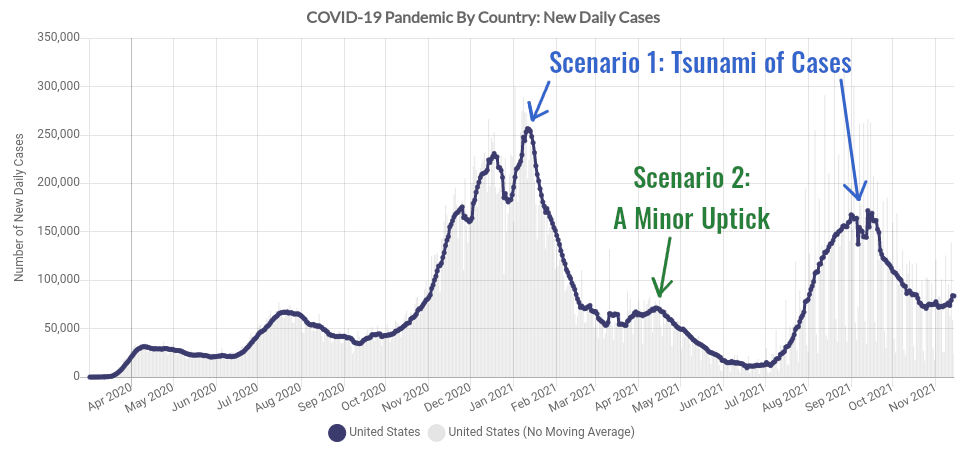
The IHME model agrees. Its official projection calls for a minor uptick of COVID-19 cases over the holidays. Only in the worst case scenario do you see anything like what the U.S. experienced this summer.

COVID-19 Simulator Model
The COVID-19 Simulator is run by Massachusetts General Hospital, Harvard Medical School, Georgia Tech, and the Boston Medical Center. We’ve used it in many of our past analyses and forecasts. It has been reliable and accurate throughout the duration of the COVID-19 pandemic.
Because I’m not expecting that the United States will make very many changes to the current COVID-19 protocols, let’s initialize the model to run on the current interventions for the full 16 week projection. To account for waning immunity, let’s also bump the vaccine efficacy down to 75% from its default 90%.
The COVID-19 Simulator falls largely in agreement with the IHME. In a worst-case scenario, new daily case loads would remain below the September, 2021 surge, peaking around 148,000 new cases daily. However, the far more likely scenario is that you’ll see a slight bump in cases as people gather for the holidays. Hopefully, once that’s done, we can have a much clearer view of the COVID-19 pandemic’s end game.

Massachusetts Institute of Technology Model
The MIT Model is based off of the SEIR (Susceptible, Exposed, Infected, Removed) Model. Like our model, it accounts for features specific to the COVID-19 pandemic, such as government intervention, vaccinations, and human behavior. And it’s probably the most optimistic of the three models. It doesn’t expect much, if any, surge due to the holidays. In fact, it predicts that the United States will only gain about 1 million more cases in the eight-week period between now and late January, 2022.
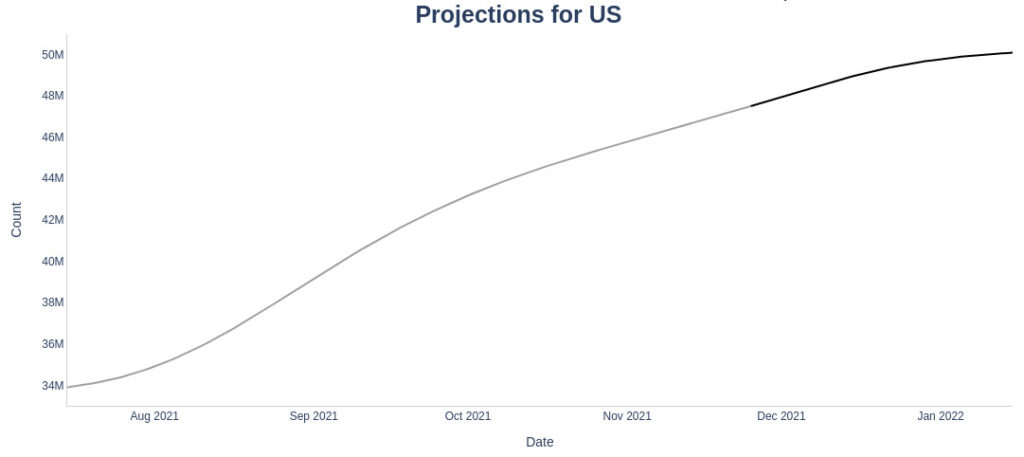
^ Cumulative case projections from the MIT Model ( https://www.covidanalytics.io/projections)
Places Delta Has Hit Hard Appear to Be Reaching Herd Immunity
One very encouraging pattern that has emerged is that places that the Delta Variant has hit very hard to not appear to be getting much by way of reinfections. Indeed, cases loads and risk levels across the southeastern United States are at the lowest levels they’ve been since the beginning of the pandemic.

This pattern is becoming prevalent around the world. India and Indonesia both experienced major spikes of the Delta Variant between April and July. Both countries have brought new case loads to near record lows and have kept them there. You can say the same thing for Japan. Following the Olympics in July, Japan experienced a major Delta Variant Spike. It’s now reporting less than 200 new cases per day. Even Brazil, which has had a moderate burn throughout the pandemic instead of a big spike, has gotten new case loads down to their lowest levels since May, 2020.
While these are only a few examples, this scenario is playing out in countries on all 7 continents.
Watch the Southern Hemisphere for a Preview of the COVID-19 End Game
Throughout the pandemic, Southern Hemisphere winters (June to September) have offered a glimpse into what the Northern Hemisphere should expect for its winters. While they haven’t been a perfect crystal ball, they have at least gotten us in the ball park for what to expect. And even though not all Southern Hemisphere countries have experienced a spike of the Delta Variant, the ones that did have all gotten case loads down to near record lows and kept them there.
Southern Hemisphere countries on the African continent have had particular success at keeping case loads down following a Delta Variant spike. And keep in mind, vaccines are still few and far between in many of those countries. In fact, the Southern Hemisphere as a whole seems to confirm the models’ predictions that the end game for the COVID-19 pandemic will come in 2022. However, for the best previews of what the United States has in store, I would watch Australia and South Africa.
How Close is the United States to Herd Immunity?
It’s hard to say for sure how close the United States is to herd immunity, but we can run some back-of-the-envelope calculations to get a ballpark number. First and foremost, there are likely far more actual infections than the data show. And that’s true in every single country across the board. The data only contains diagnosed cases from tests. With so many cases either asymptomatic or mild, many people did not get tested even though they contracted COVID-19.
Even though the U.S. has about 48 million positive tests, experts believe that the actual number of cases could be as high as 200 million. However, I think that it’s unlikely that high. Instead, let’s use the COVID-19 Simulator’s best estimate of total U.S. cases: 157 million.
US Population = 330 million
Estimated Cases = 157 million
157 million / 330 million = 47% of population has contracted COVID-19Now, we’ll add in the vaccinations. About 59% of the U.S. population is fully vaccinated. However, we must keep in mind that a portion of the vaccinated population has also contracted COVID-19, either before vaccines were available, or as a breakthrough case. For purposes of this argument, let’s assume that half of the vaccinated population has also contracted COVID-19. When calculating the total population that has immunity, we’ll need to subtract those from the vaccinated pool so they’re not counted twice.
330 million * 0.59 = 195 million fully vaccinated
195 / 2 = 98 million vaccinated, but have not contracted COVID-19
157 million infections + 98 million vaccinated = 255 million immunized
255 million immunized / 330 million population = 77% of population immunizedIt’s believed that 90 to 95 percent of the population must be immunized to reach full herd immunity against the Delta Variant. The United States isn’t quite there yet, but it’s getting close. These calculations also point to the COVID-19 end game coming in 2022.
A Tale of Caution: Zero-COVID Strategy Does Not Work Against the Delta Variant
Unfortunately, not every country is succeeding in the war against COVID-19. Europe has once again become the epicenter of the pandemic. Cases are surging in New Zealand. Much of Southeast Asia and Oceania are coming down off of record Delta spikes. What do these countries have in common? They all adapted a zero-COVID strategy at the onset of the pandemic, and the Delta Variant is forcing them to abandon that strategy because of its extraordinarily high transmissibility.
Can Zero-COVID Countries End the Pandemic with Vaccines?
It’s unlikely vaccines alone will end the pandemic. The Delta Variant is so contagious and transmissible that you’d need to vaccinate more than 95% of the population to reach herd immunity through vaccination alone. However, that doesn’t mean vaccines can’t suppress clusters, waves, and hotspots. Just have a look at Europe.
| Country | Percent Fully Vaccinated |
|---|---|
| Portugal | 86.69 |
| Spain | 79.55 |
| Germany | 67.53 |
| Czechia | 57.96 |
This graph tells the whole story.
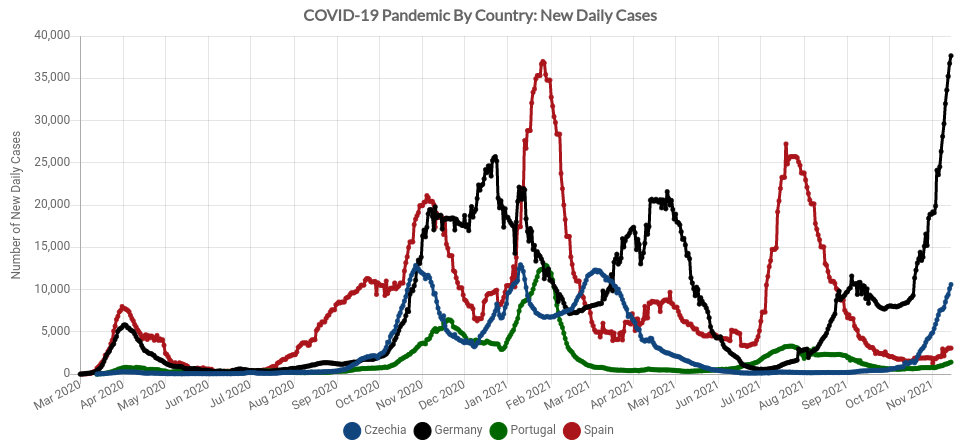
So what does this all mean for Europe? Europe is likely going through the same Delta spike that the United States and so many other countries saw back in July and August. Did you notice on the figure above that neither Germany (black line) nor Czechia (blue line) had a major COVID-19 surge over the summer of 2021, while Spain did?
Rapid Vaccine Rollout Kills One-and-Done Delta Spikes in Southeast Asia
Southeast Asia had done a stunningly good job controlling COVID-19 until the Delta Variant arrived in May, 2021. After abandoning their zero-COVID strategy, many countries saw horrific Delta spikes as the variant ripped through the population. But the pattern has mirrored what the rest of the world has seen. You get one major spike in cases, and once it peaks, you can quickly suppress it through both vaccines and natural immunity.
Three countries in Southeast Asia really stand out for having some of the highest vaccination rates in the world. They are Cambodia, Malaysia, and Singapore. All three countries saw a major Delta spike earlier this year, and rapidly rolled out vaccines to kill the outbreak in its tracks. Even neighboring Thailand is seeing remarkable success despite having a much lower vaccination rate. Unlike the United States, all four countries continue to rapidly vaccinate their populations.
| Country | Percent Fully Vaccinated |
|---|---|
| Singapore | 82.47 |
| Cambodia | 80.06 |
| Malaysia | 77.56 |
| Thailand | 51.32 |
The lesson for the United States here is that it, too, can keep the Delta Variant at bay. Even if it can’t ramp up its vaccination rate, highly-effective new treatments coming on the market should help blunt the death rate, even in the unvaccinated. Herd immunity is in sight, but you can’t rule out another surge this winter. We just need do everything we can to get there as quickly and safely as possible.
Conclusion
It’s been a long two years, but the end game for the COVID-19 pandemic seems to be finally starting to come into focus. As weird as it sounds, the Delta Variant is actually helping us end the pandemic. It has kept other variants at bay, while establishing a clear pattern around the world. You’ll need to endure one major spike from the Delta variant. And once that’s finished, when coupled with a high vaccination rate, herd immunity should be in sight.
The United States has already endured the worst of the Delta spike. Whatever surge we get this winter should be minor in comparison. The combination of highly effective vaccines and treatments is the silver bullet we’ve been waiting 2 years for. Let’s finally put an end to all of this once and for all.
